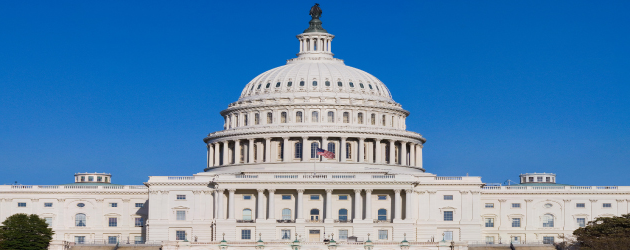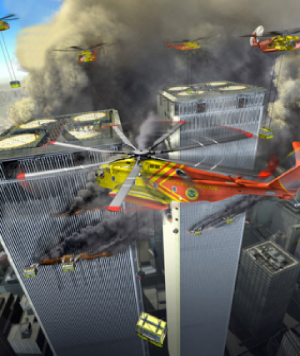To insure the safety, security, and defense of high-rise buildings from terrorist attacks, accidents, or natural acts, within the United States.
SECTION 1. SHORT TITLE
This Act may be cited as ‘The Skyscraper Defense Act’. Herein The Skyscraper Defense Act is referred to as ‘The Act’.
Sec. 2. FINDINGS / PURPOSE
A. Findings – Congress finds the following:
1. The destruction of a skyscraper as the result of a terrorist attack, natural act, or accident, within the United States would be an act of extraordinarily high consequences and could lead to the death of many innocent people;
2. The destruction of a skyscraper as the result of a terrorist attack could lead to an armed conflict inside or outside the United States resulting in the death of many thousands, in the expenditure of billions of taxpayer dollars, and negatively affect America’s relationship with other countries;
3. A clear declaration by the United States affirming that the safety, security, and defense of its high-rise buildings from terrorist attacks, natural acts, or accidents, is of the highest priority will insure skyscraper defense measures meet established standards while serving as a deterrent to would be terrorists;
4. A clear declaration by the United States that the safety, security, and defense of its high-rise buildings from terrorist attacks, natural acts, or accidents, is of the highest priority would set an example for other countries and possibly increase the number of worldwide buildings with defensive measures in place.
B. Purpose – The purpose of The Act is:
1. To affirm Congress’ authority and responsibility under Article I, Sect. 8, Clause 14 of the US Constitution, to make rules for the government and regulation of the safety, security, and defense of high-rise buildings from terrorist attacks, natural acts, or accidents;
2. To affirm Congress’ authority and responsibility under the Constitution Article I, Sect. 8, Clause 1, “provide for the common Defense”; Clause 10, “to define and punish … Offences against the Law of Nations”; Clause 11, “To declare War”; Clause 12, “To raise and support Armies”; Clause 18, “to make all laws which shall be necessary and proper for carrying into execution the foregoing powers”.
Sec. 3. INTERPRETATION
A. The Act is not intended to circumvent local authority, including cities, counties, and/or states, from exercising defensive measures of their high-rise buildings from terrorist attacks, natural acts, or accidents. Rather, The Act is designed to supplement local authority with federal resources.
B. The Act cannot be repealed by implication.
Sec. 4. DEFINITIONS
A. For the purposes of The Act, the following terms are deemed synonymous:
1. Skyscraper;
2. High-rise;
3. Tall building.
B. All buildings, 25 floors or more, are covered by The Act. Buildings less than 25 floors may be covered by The Act if so ordered by the Skyscraper Defense Agency (see Section 5, Paragraph A below).
C. ‘Major City’ is defined as a city with a current census of 1 million people or more.
D. ‘Major Emergency’ is defined as an event that threatens lives within a building covered by The Act and/or the physical integrity of a building covered by The Act.
Sec. 5. DESIGNATION / PERSONNEL
A. Creation of the ‘Skyscraper Defense Agency’ (SDA) within the Homeland Security Department:
1. Responsible for the safety, security, and defense of all high-rise buildings, subject to The Act, within the United States;
2. Responsible for certifying in-place defensive measures, for all buildings subject to The Act, including but not limited to helicopter landing zones, robotic and manned firefighting equipment, refuge centers, and on demand oxygen systems;
3. Responsible for determining which buildings less than 25 floors in the United States meet the intent of The Act. (Factors to include prominence in the skyline of a city and/or ’symbolic importance’.);
4. Responsible for designating specific high-rise buildings as ‘High Profile Buildings’ and, therefore, subject to additional safety, security, and defense requirements.
B. Creation of presidential appointee position, subject to senate confirmation, entitled ‘Director of Skyscraper Defense’ (DSD):
1. DSD to oversee preventive measures to insure safety, security, and defense of skyscrapers subject to The Act;
2. DSD to coordinate emergency responders, including city, county, state, and private, when buildings subject to The Act are involved in a major emergency.
C. Creation of teams of ‘Skyscraper Defenders’ in each major city in the United States:
1. Each team to be composed of no less than 20 members;
2. Each team member to be trained in all aspects of skyscraper safety, security, and defense including: firefighting, rescue, EMS, counter-terrorism, explosive detection, communications, buildering, rappelling, and base jumping;
3. Skyscrapers designated as ‘High Profile’ by the SDA shall be required to maintain a team of Skyscraper Defenders 24/7 on the building’s premises in locations as mandated by the SDA;
4. SDA to determine the cities or areas, outside of major cities, that warrant the creation of teams of Skyscraper Defenders.
Sec. 6. PROTOCOLS / EQUIPMENT
A. All future skyscrapers, including skyscrapers currently under construction, to incorporate an independent oxygen delivery system on each floor:
1. Oxygen masks and oxygen ‘hook-ups’ to be made available for all occupants including emergency workers;
2. Sufficient number of oxygen masks, based on historical trends, to be made available for building visitors.
B. A dedicated squadron of no less than eight heavy-lift helicopters based in each major city in United States:
1. Each helicopter to be equipped with foam canons and heavy-lift hydraulic winches;
2. Each helicopter to be equipped with a computer system capable of remotely operating in-place robotic firefighting pods on a SDA designated building;
3. Each helicopter to be equipped with a computer system capable of deploying ‘portable’ robotic firefighting pods onto a SDA designated building lacking functional in-place robotic firefighting pods.
C. Development of ‘firefighting pods’, both manned and robotic. Pods to be located along a skyscraper’s roof and/or a secure location accessible to heavy-lift helicopters. Both versions of firefighting pods to be armed with firefighting cannons, halogen lights, infrared cameras, and fireproof shell:
1. The robotic firefighting pod (RFP) is designed as the initial response to a major fire in a high-rise building;
2. The manned firefighting pod (MFP) is designed to ‘follow-up’ the RFP with Skyscraper Defenders equipped and capable of entering the building where necessary.
D. Development of fireproof ‘rescue gondolas’ for delivery by heavy-lift helicopters to the building’s roof or other locations on or near the building. Gondolas, with a loading capacity of no less than 12 persons, to be used to deliver Skyscraper Defender teams and/or remove building occupants.
E. Development of simulation training programs tailored made for specific major cities and specific skyscrapers:
1. For purposes of training Skyscraper Defender team members for worst-case scenarios for a particular skyscraper;
2. For purposes of training Skyscraper Defender team members stationed aboard helicopters for on-board solutions to worst-case scenarios;
3. For purposes of preparing permanent building occupants for building evacuations and ‘emergency instructions’;
4. Insure in place defensive measures are fully operational and current;
5. Generate recommendations for improvements.
F. Major cities to create a ‘master plan’ for each high-rise within its metropolitan area:
1. Skyscraper Defenders to oversee training of local emergency responders;
2. Skyscraper Defenders to coordinate emergency activities of local emergency responders.
G. Future skyscrapers, including high-rises currently under construction, required to incorporate ‘refuge centers’ of sufficient size to accommodate the center’s pro-rata share of permanent building occupants and projected visitors as appropriate throughout the building, including a refuge center one floor below the roof:
1. Refuge center to be fireproof and reinforced as a ‘hardened bunker’ with dedicated air, water, and power supply;
2. Refuge center to have emergency egress doors positioned to enable occupants to board an external elevator/escape pod for transporting to the roof and/or enable occupants access to a helicopter pad incorporated into the structural design.
H. Future skyscrapers, including high-rises currently under construction, required to incorporate no less than two SDA certified helicopter ‘landing zones’ into the design of the building:
1. Landing zones to be located on the roof and/or other locations via a system certified by the SDA;
2. Skyscrapers requiring multiple refuge centers shall be required to have additional helicopter landing zones as determined by the SDA.
I. Future skyscrapers, including skyscrapers currently under construction, to incorporate external fireproof elevators/escape pods:
1. Each external elevator/escape pod to be equipped with dedicated power and air supply;
2. Each external elevator/escape pod to be compartmentalized in the upper refuge center or incorporated into the architectural design of the building’s exterior.
J. Future skyscrapers, including high-rises currently under construction, shall incorporate emergency egress stations on each floor for the purpose of evacuating occupants via external elevator/escape pods.
K. Future skyscrapers, including high-rises currently under construction, to incorporate dedicated standpipes on each floor plus:
1. Sufficient fire hose to adequately cover the floor;
2. Additional firefighting equipment deemed necessary by ‘Standards and Guidelines’ issued by the SDA.
L. Permanent building occupants required to attend annual ‘Building Emergency Seminar’ conducted by Skyscraper Defenders:
1. Operation of standpipes and use of hose;
2. Basic fire suppression techniques including creation of fire blocks;
3. Evacuation procedures;
4. Review of the building’s built-in defense.
M. All future skyscrapers to incorporate ‘green’ building materials (defined as 100% fireproof and free of toxic chemicals such as ‘cyanide’):
1. Carpets, furniture, cabinets, computers, draperies, and other materials introduced into the building, to be made from ‘green’ materials;
2. Future building designs to incorporate green technology exceeding current LEED’s strictest requirements with a goal of creating an energy independent, completely self-contained skyscraper.
N. Due to a plethora of used airplanes and unregulated airways, and the possibility of missiles, The Act supports the development and deployment of an anti-aircraft/missile system utilizing a sonic blast of air or sound to ward off rogue aircraft and missiles.
O. Existing skyscrapers, deemed by the SDA to be ‘a high profile terrorist target’, are required to retrofit:
1. Retrofits to include helicopter landing zones, refuge centers, firefighting pods, external evacuation pods/elevators, and emergency egress stations;
2. Availability of low interest, government loans and tax incentives to cover cost of retrofits.
P. Establishment of a rating system for skyscraper safety. Factors such as, but not limited to, sprinkler systems, standpipes, helicopter pads, roof top access, refuge centers, and firefighting pods, will be quantified then converted into a numerical score. Achievement of a minimum score enables a building to receive a ‘Skyscraper Defense Certified’ status. A building’s status will be regularly updated and available to all concerned parties, including fire departments, police departments, insurance companies, banks, and commercial real estate companies, via the SDA’s website.
Q. Should a major emergency occur involving a skyscraper covered by The Act, the SDA will appoint an investigative team, including forensic experts, structural engineers, and criminal investigators, to determine the cause of the calamity:
1. Based on the results of the investigation, the SDA may make recommendations for existing and future skyscrapers;
2. SDA’s investigation to be fully transparent.
R. High-rise building occupants to be afforded an official ‘Occupant’s Bill of Rights’ including:
1. An occupant’s right to know their building’s safety rating;
2. 24/7 access to the roof;
3. 24/7 availability of oxygen to all floors;
4. Regular evacuation drills held in conjunction with local emergency responders.




